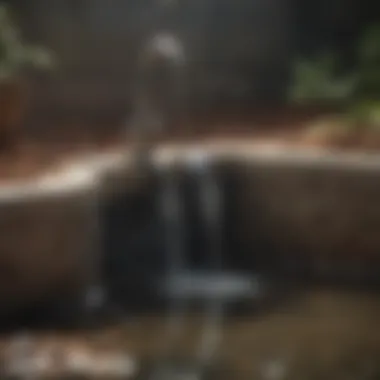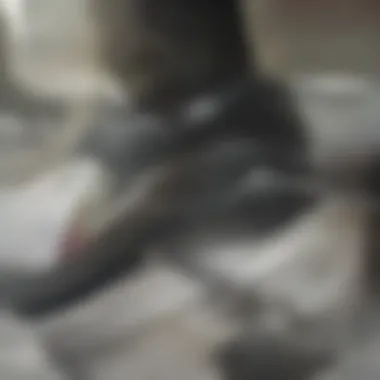Effective Solutions for Clogged Drains: Techniques and Tools


Intro
Clogged drains are an issue that affects many households. They can cause inconvenience and lead to bigger plumbing problems if not addressed in a timely manner. Understanding the signs and solutions for clogged drains is essential for effective household maintenance. This comprehensive guide examines various methods, materials, and strategies to handle drainage issues.
Understanding Drain Blockages
A clogged drain can occur due to a variety of reasons. Common culprits include hair, grease, soap residue, and foreign objects. Recognizing the signs of a blockage is critical. Sometimes, you may notice slow drainage, unpleasant odors, or gurgling sounds when water flows through the pipes.
Taking proactive measures is necessary to maintain effective drainage.
Types of Drain Obstructions
There are numerous types of blockages. Some are simple to fix, while others may require professional assistance.
- Hair: One of the most frequent causes of clogged shower drains.
- Grease: Kitchen sinks often suffer from grease build-up.
- Foreign Objects: Small items like toys or utensils can obstruct flow.
Recognizing the type of blockage is the first step toward selecting the appropriate solution.
Preventive Strategies
Prevention is often better than cure. Simple actions can make a significant difference.
- Regularly clean drain stoppers and traps.
- Avoid pouring grease down the kitchen sink.
- Use a drain cover to catch debris.
By implementing these practices, homeowners can reduce the risk of blockage.
Natural Solutions
Several natural methods exist to remedy clogged drains. These solutions are often safe for both pipes and the environment.
- Baking Soda and Vinegar: This combination can effectively dissolve minor clogs. Pour half a cup of baking soda down the drain, followed by half a cup of vinegar. Allow it to fizz, then flush with hot water.
- Salt and Hot Water: Pouring a mixture of salt and boiling water can break down grease.
These methods are simple, cost-effective, and environmentally friendly.
Chemical Solutions
When natural methods fail, chemical solutions may provide relief. Popular products include Liquid-Plumr and Drano. Use these with caution, as they contain harsh chemicals that can damage pipes if improperly applied. Always follow instructions carefully.
Ensure adequate ventilation during use to minimize harmful fumes.
Closure
Understanding how to solve and prevent clogged drains is essential for every homeowner. Maintaining clear drainage helps avoid more significant issues down the line. By using the right techniques and tools, one can ensure optimal water flow and a healthy plumbing system.
The tips and solutions provided will aid readers in dealing with their unique situations effectively.
Understanding Clogged Drains
Understanding clogged drains is essential in maintaining a healthy plumbing system. Clogs are not merely inconveniences; they can lead to significant issues if not addressed promptly. Knowing the causes and signs of clogged drains helps homeowners take timely action, potentially saving costly repairs. This section provides insights into the contributing factors behind clogs and the symptoms to look for, ensuring optimal water flow and hygiene in living spaces.
Causes of Drain Clogs
Hair Accumulation
Hair accumulation is one of the most common culprits of clogged drains. Hair strands can easily bind with soap residue or grease, creating a thick obstruction. This blockage can cause water to back up, leading to slow drainage. It is vital to understand that hair clogs typically occur in bathrooms, especially in showers and sinks.
Key characteristics of hair accumulation include its ubiquity in households and the ease with which it blends with other materials. A major disadvantage is that it often goes unnoticed until significant blockage occurs. Regular brushing and using drain screens can minimize hair accumulation.
Food Particles
Food particles contribute significantly to kitchen drain clogs. When food waste is washed down the sink without proper disposal methods, it can accumulate and lead to serious obstructions. This is particularly true for greasy or fibrous foods that do not dissolve easily in water.
Food particles are notable for their ability to bind with other materials like grease, creating a dense clog. While they are essentially organic materials, their lingering nature can create foul odors and attract pests if not managed. Employing food disposal units or composting can be effective in reducing such clogs.
Grease Buildup
Grease buildup is a well-known issue, especially in kitchens. Cooking oils and fats often solidify and adhere to pipe walls, restricting water flow over time. This greasy residue can trap food particles, exacerbating the clog.
What makes grease a critical topic is its tendency to mix with various substances, creating formidable blockages. While it is easy to pour grease down the drain, it can lead to severe consequences. Installing grease traps or disposing of fats properly can mitigate this problem.
Foreign Objects
Foreign objects are items that accidentally fall into drains, leading to unexpected clogs. This can include anything from small toys to dental floss. Unbeknownst to many, even minor objects can create significant restrictions in pipe flow.


The distinctive feature of foreign objects is their unpredictability. They can cause immediate blockage and may require more intensive removal methods. Educating household members about what should not go down the drain is key in preventing these situations.
Common Signs of Clogged Drains
Slow Draining Water
Slow draining water often signals an imminent clog. When water does not flow freely down the drain, it can indicate that buildup is present. This issue can be especially troublesome in kitchens and bathrooms.
This characteristic is advantageous because it serves as an early warning sign. Timely identification can lead to prompt action before the situation worsens. Regular monitoring of water flow when using sinks and tubs is essential for awareness.
Unpleasant Odors
Unpleasant odors from drains can sometimes indicate material decay or stagnation in pipes. These odors might stem from trapped food particles or waste buildup. Recognizing these smells early is crucial.
The key aspect of unpleasant odors is their ability to pervade living spaces, signaling a blockage risk. Addressing these smells quickly can prevent further plumbing issues and preserve home hygiene. Cleaning the drain regularly can help prevent these odors.
Gurgling Sounds
Gurgling sounds can alert a homeowner to potential drain issues. When air bubbles struggle to escape due to a blockage, a gurgle may be heard. This sound often indicates that water is having difficulty passing through.
Recognizing gurgles can be beneficial as it reveals ongoing issues before they escalate. Investing time to investigate these sounds can lead to quicker resolutions and enhanced plumbing life.
Overflow or Backup
Overflow or backup is a serious sign of a clogged drain requiring immediate attention. When water spills over instead of draining, it indicates a major blockage further down the plumbing system.
The critical aspect of overflow is its potential to cause water damage, leading to costly repairs. Timely attention to such signs can prevent extensive damage to property. Homeowners should take note of sudden spills as a call to action.
Preventive Measures for Clogged Drains
Preventing clogged drains is an essential aspect of home maintenance. This topic impacts not just the sustainability of plumbing systems but also the quality of living spaces. Taking preventive measures reduces the risk of unexpected clogs, saving time and money on repairs. Homeowners can avoid future issues by implementing regular practices and making informed choices about waste disposal.
Regular Maintenance Practices
Routine Cleaning
Routine cleaning is fundamental for keeping drains in optimal condition. Regularly removing buildup from sinks and showers prevents blockages before they start. This practice is straightforward and does not require sophisticated tools. Homeowners can use a combination of warm water and mild soaps to cleanse the surfaces.
- Key characteristic: Routine cleaning helps remove potential debris before it hardens.
- Beneficial choice: It is easy to incorporate into cleaning schedules.
- Unique feature: Maintains the efficiency of drainage systems overall.
- Advantages: Creates a proactive approach to plumbing care.
- Disadvantages: May require regular time commitment.
Using Drain Screens
Using drain screens is an effective method to minimize the entry of larger debris into plumbing systems. These screens catch hair, food particles, and other objects, thereby significantly reducing the volume of material that can lead to clogs. Screens can be purchased at home improvement stores and are simple to install.
- Key characteristic: They act as a physical barrier against obstruction.
- Beneficial choice: Easy to use and maintain, requiring occasional cleaning.
- Unique feature: They allow water to flow freely while trapping unwanted materials.
- Advantages: Very effective in preventing clogs before they begin.
- Disadvantages: Needs periodic cleaning; otherwise, screens can become clogged themselves.
Educating Household Members
Educating household members about proper drain usage is critical. By conveying the importance of what can and cannot go down the drain, avoidance of clogs can be significantly improved. This approach fosters a shared responsibility among all household members.
- Key characteristic: Creates awareness of waste disposal.
- Beneficial choice: Empowers everyone in the home to play a part in drain maintenance.
- Unique feature: Practical discussions can lead to lasting behavioral changes.
- Advantages: Increases collaboration in maintaining clean drains.
- Disadvantages: Ensuring everyone commits to changing habits can take time.
Choosing Appropriate Disposal Methods
Proper Food Disposal
Proper food disposal is vital for avoiding kitchen drain clogs. Disposing of food waste through composting or placing it in trash bins instead of washing it down the sink can prevent significant issues. Understanding which food items might cause clogs, such as starchy or fibrous materials, is essential for maintaining a clear drain.
- Key characteristic: Minimizes the introduction of problematic materials into plumbing systems.
- Beneficial choice: Leads to healthier pipes and reduced risk of backflow.
- Unique feature: Encourages environmentally friendly waste solutions.
- Advantages: Reduces the need for chemical cleaners and extensive clean-ups.
- Disadvantages: Requires a change in disposal habits.
Avoiding Non-Dissolvable Items
Avoiding non-dissolvable items such as wipes, sanitary products, and certain plastic materials is paramount. These items do not break down in water, leading to blockages. By educating household members about these items, the integrity of the drain can be preserved.
- Key characteristic: Prevents physical blockages that can form over time.
- Beneficial choice: Encourages responsible waste disposal habits.
- Unique feature: Focuses on long-term drain health rather than short-term fixes.
- Advantages: Reduces future drain-related costs and repairs.
- Disadvantages: Requires constant vigilance to ensure compliance.


Natural Remedies for Clogged Drains
Natural remedies for clogged drains provide an eco-friendly alternative to harsh chemical solutions. Many people prefer these methods due to their effectiveness and minimal harm to the environment. Using common household items, such as baking soda and vinegar, offers a safer way to address drainage issues. These remedies can prevent damage to plumbing systems and reduce potential health hazards associated with toxic substances.
Baking Soda and Vinegar
Application Process
To apply the baking soda and vinegar method, start by clearing the drain of any visible debris. Pour about half a cup of baking soda directly into the drain. Follow this with half a cup of vinegar. It is important to ensure that the vinegar is poured quickly to create a fizzing reaction. Cover the drain with a cloth or plug to contain this reaction for about 30 minutes. Finally, flush with boiling water to help clear any remaining residue. This method is widely popular due to its simplicity and the availability of materials.
The reaction between baking soda and vinegar helps break down build-up and can effectively clear minor clogs. One key characteristic is its non-toxic nature, making it a safe choice for households with children or pets. However, the effectiveness varies depending on the severity of the clog. It may not be sufficient for deeper, more stubborn blockages.
Expected Results
The expected results from using baking soda and vinegar include the breakdown of organic matter and a cleaner drain. Users often notice a reduction in unpleasant odors and a return to normal water flow. This method is appealing because it typically costs less than commercial products, and its ingredients are likely already in one's kitchen.
While it may not eliminate all forms of blockage completely, it often serves as a first-line solution. One unique feature of this approach is its dual action: cleaning while deodorizing. Although it is generally safe, heavy or frequent use may lead to occasional build-up of excess sodium in pipes, which can be counterproductive.
Boiling Water
How It Works
Boiling water offers a straightforward method for clearing clogs. The high temperature of the water helps to melt and dissolve grease, fats, or soap that may have built up in pipes. To use this method, simply boil a pot of water and pour it slowly down the drain in stages, allowing it to work for a few minutes between each pour. This method is beneficial due to its efficiency and low cost.
One key characteristic is the immediate action provided; boiling water works quickly to address soft blockages. It is most effective for clearing lighter clogs. However, there are types of materials that boiling water cannot displace. For example, roots from trees or other rigid obstructions will not respond to this heat treatment.
Safety Considerations
Safety considerations are important when using boiling water. The user must ensure that the water is not poured hastily, as this can lead to splashing and potential burns. Also, porcelain, plastic, or certain pipe materials might not handle the temperature well. Using boiling water can cause damage to these sensitive areas.
It is essential to assess the type of plumbing involved before applying the boiling water method. In general, this method is useful but should be approached with caution to avoid unintended damage.
Chemical Solutions for Clogged Drains
In addressing clogged drains, the use of chemical solutions emerges as a significant aspect in the remediation process. These solutions often provide a rapid and effective way to dissolve obstructions that can lead to slow drainage or complete blockage. Their importance lies not only in their effectiveness but also in their convenience, as many are ready for immediate use in tackling common drainage issues. However, it is critical to approach these chemical methods with caution due to their potential risks, which will be discussed in detail.
Store-Bought Drain Cleaners
Store-bought drain cleaners come in various formulations, designed to tackle specific types of clogs. Common types include liquid, gel, and foaming cleaners, each offering unique advantages and target capabilities.
- Liquid Cleaners: These are typically the most popular option, as they work quickly to dissolve clogs caused by grease, hair, and other food particles. They are often preferred for their fast action and user-friendly application.
- Gel Cleaners: Gel formulations tend to adhere longer to the sides of pipes, giving them more time to break down blockages. They are especially useful in vertical applications, as they minimize the risk of running down without cleaning the pipes effectively.
- Foaming Cleaners: These expand in the pipe to ensure they reach the clogs more effectively. They actively seek out debris and are particularly useful in treating larger blockages.
The key characteristic that makes these cleaners beneficial is their ease of availability and straightforward usage. Most homeowners can purchase them in retail stores without prior experience or special tools. It is essential to recognize the unique features of these cleaners, such as the caustic chemicals they often contain, which can be both advantageous in removing blockages but also raise caution regarding their use.
Usage Instructions
Understanding how to properly use store-bought drain cleaners is vital. Instructions typically recommend flushing the drain with hot water before application, allowing the cleaner to work more effectively. Each product may differ, so it is crucial to follow the manufacturer's specific guidelines.
Key characteristics of these instructions include:
- Measuring the correct amount of cleaner.
- Allowing sufficient time for the chemical to act.
- Flushing the drain again with hot water to ensure removal of loosened debris.
Following usage instructions can maximize the cleaner's efficiency and minimize potential damage to pipes. Misuse can lead to excessive chemical accumulation, which might not only be ineffective but hazardous to your plumbing system.
Risks Associated with Chemical Solutions
While chemical solutions can be effective, they also carry inherent risks that should not be overlooked, particularly concerning toxic fumes and pipe damage.
Toxic Fumes
Toxic fumes from chemical drain cleaners pose a serious concern during or after their application. These fumes can be harmful to human health, with effects ranging from mild irritation to more severe respiratory issues. Products frequently contain substances that can release vapors harmful when inhaled.
Highlighting the risks of toxic fumes emphasizes why adequate ventilation is essential when using these products. Users must take precautions and use personal protective equipment, such as gloves and respiratory masks, to mitigate exposure. The unique feature of these fumes is their ability to linger in enclosed spaces, increasing health risks long after the initial application has been made.
Pipe Damage


Another critical aspect to consider is the potential for pipe damage. Many store-bought cleaners contain strong acids or bases that can corrode pipes over time. Copper, PVC, and older sewer lines are particularly susceptible to damage.
People should be aware that repeated use of harsh chemicals can lead to costly repairs or replacements down the line. Therefore, understanding the specific nature of your plumbing system will aid in choosing the correct product and using it safely. The importance of this consideration cannot be overlooked, as safeguarding your plumbing infrastructure is vital for long-term home maintenance.
Using chemical solutions requires a balance between effective clog removal and the health of your plumbing system. Always use these products responsibly.
Physical Methods for Clearing Clogs
Addressing clogged drains is essential for maintaining the overall health of plumbing systems. Physical methods offer straightforward approaches to tackle these issues by manually removing blockages. Unlike chemical solutions, physical techniques are often safer for both users and the environment. They allow individuals to exert direct control over their plumbing problems while minimizing risks like pipe damage or harmful exposure to toxic fumes. Moreover, many of these tools are accessible and do not require professional help, making them a pragmatic choice for homeowners.
Plungers
Types of Plungers
Plungers are among the most well-known tools for clearing drains. There are two primary types: cup plungers and flange plungers. Cup plungers are ideal for flat surfaces like sinks, while flange plungers are specifically designed for toilets. The flange feature adds an additional barrier that creates better suction, making them particularly beneficial for tricky clogs. Their versatility is a key characteristic, allowing them to be used in various drainage contexts effectively. However, it's important to choose the right type of plunger based on the clog’s location.
Best Practices
Implementing best practices is crucial when using plungers. One effective method is to ensure that there’s enough water in the basin to cover the plunger’s cup. This water aids in creating the required suction to dislodge the clog. Another tip is to ensure a tight seal around the drain for effective results. When using a plunger, pump it vigorously without lifting it from the drain—this helps maintain the pressure needed to clear obstructions. Although these practices are beneficial, improper use can sometimes push the clog further down the drain, making it harder to clear.
Augers and Snake Tools
YouTube Tutorials
Augers and snake tools provide an effective solution for deeper clogs that plungers might not reach. YouTube tutorials have become invaluable resources for learning how to appropriately use these tools. They provide visual reference and step-by-step guidance, significantly simplifying the learning process. Many tutorials break down complex techniques into easy-to-follow segments. This accessibility makes it simple for even novices to tackle their plumbing problems. However, viewing numerous videos may lead to confusion if there’s inconsistent advice.
Professional Guidance
For those unsure about tackling clogs on their own, professional guidance can be extremely helpful. Consulting with experienced plumbers can save time and prevent mistakes. They offer insights into optimal techniques and recommend suitable tools for specific drain issues. Professional advice also ensures that the right methods are applied, reducing the risk of damage to plumbing. However, it is important to note that not all guidance will be free, so weighing the costs versus the benefits is essential.
When to Call a Professional
Calling a professional plumber can feel daunting. However, there are critical moments when intervention is absolutely necessary. Ignoring more severe drainage issues can lead to significant damage and hefty repair costs. This section will help you understand when it's time to reach out for professional help.
Indicators of Severe Clogs
Frequent Recurrence
Frequent recurrence of clogs in your drainage system is a strong indicator that something more serious is at play. It suggests that you may be facing underlying plumbing issues rather than just superficial blockages. Every time a clog returns after your best efforts to eliminate it, the root cause remains unresolved. This ongoing struggle not only wastes time but can also lead to deeper, more costly problems if left unchecked.
The key characteristic of frequent recurrence is its repetitive nature. Each appearance of the clog demonstrates the need for a professional's expertise. Many homeowners find it beneficial to consult an expert in these situations. A qualified plumber can accurately diagnose the underlying issue, whether it be tree root invasions, pipe corrosion, or a misconfigured drainage system.
The unique feature of recognizing frequent clogs lies in the peace of mind it can provide. Knowing that you are addressing the root issue can save money in the long run, preventing minor problems from escalating into daunting catastrophes.
Multiple Drains Affected
If you notice multiple drains in your home backing up, this is a strong indication of a more significant plumbing issue. Instead of isolated problems, this suggests that a centralized clog may be present further along in the system. Addressing this is crucial to prevent widespread damage to your plumbing.
A key characteristic of multiple drains being affected is the interconnected nature of your drainage system. The impact can spread quickly if one drain malfunctions, leading to potential flooding and structural damage. This scenario can have serious consequences, thereby making it vital to consult a professional.
The unique advantage of having a professional assess multiple affected drains is their ability to conduct a thorough inspection. Professionals often use advanced tools, such as cameras, to identify blockages in your pipes that are not easily accessible. By identifying the issue early, you significantly reduce the risk of more expensive repairs later on.
Selecting a Plumbing Service
Choosing the right plumbing service can feel overwhelming. However, understanding how to research and evaluate plumbers can lead to better outcomes.
Researching Credentials
When selecting a plumbing service, researching credentials is fundamental. This ensures that the plumber has the necessary experience and licensing to perform the work. A well-credentialed plumber has typically undergone extensive training and adheres to industry regulations. This results in more reliable service.
The key characteristic is the level of expertise and the assurance that the service will be performed correctly. A good plumber provides clarity and transparency on their qualifications, making it easier for homeowners to trust their capabilities.
The unique advantage of scrutinizing credentials is the confidence it brings. Homeowners can feel assured that they are hiring a professional who can tackle even the trickiest of plumbing challenges, thus safeguarding their home from future mishaps.
Understanding Costs
Understanding costs before hiring a plumbing service helps avoid hidden charges or unpleasant surprises later. Every business has its pricing structure, so familiarity with typical price ranges helps you make informed decisions.
The key characteristic is the transparency of pricing. A trustworthy plumber will provide an estimate that outlines the key elements of the job—taking the guesswork out of budgeting.
The unique feature of understanding costs is the ability to set a realistic budget. You avoid unexpected expenses and can better plan for any necessary repairs or replacements. Knowing the costs involved allows you to watch for rogue prices as well.
In instances of severe clogs, patience can be a liability. Engage professionals to ensure both safety and correct identification of issues.







